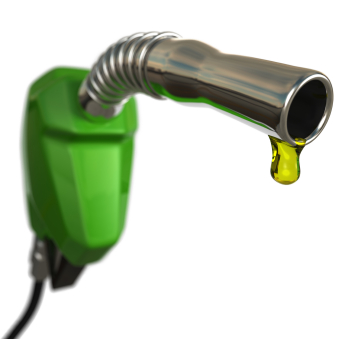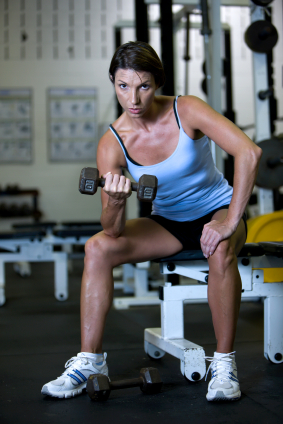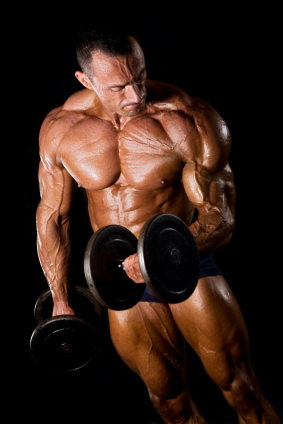
By David C. Simmons III
What is muscle made of ? Cardiac muscle cells and stomach muscle cells are involuntary muscle cells, you
cannot control them. Skeletal muscle cells are voluntary muscle cells which you
can control. The 650 skeletal muscles are made up of fibers (I imagine it like strands of spaghetti),
fibers are the muscle cells. These cells are filled with
myofibrils. Each myofibril is made up of filaments.
Its the filaments that we are interested in here. Thin filaments are made
up of the protein actin, the thick filaments are made up of the protein myosin (myosin
II).
Muscle fiber
types.
We are born with a certain
number of fibers. This number of fibers is all you get. You cannot increase the number of muscle fibers you have. Heredity dictates how many
fibers you get. When you grow muscle, you are really just increasing the size of your muscle fibers (making them thicker) by increasing the number of myofibrils.
This process is called hypertrophy.
Muscle fiber type is a very important thing to consider. There
are basically two types of muscle
fiber:
1) Slow twitch.
2) Fast twitch.
Heredity has much to do with which fiber types are more prominent
in your musculature. All of us have both, but some of us have more of one type than
another. Also, fiber types can be more pronounced in one muscle or muscle
group in one person than another.
There is lots of information on muscle fiber type, so here are
a couple of links that explain the basics :
This link is very basic and even describes the color of the muscle fibers.
This link that has good basic and a little advanced info on muscle fiber types, but its
very good. Had a popup last time I looked, just close it.
This link is excellent, and explains some great facts about muscle growth.
How muscles get the energy to move.
ATP (adenosine triphosphate) is a molecule. ATP is to muscle what
gasoline is to a car. It is produced inside the muscle cell. Muscle fatigue
during power lifting or other maximal effort lasting 0-30 seconds to failure, is
usually the result of muscle cells running out of ATP.
 There are 3 systems that produce ATP. .
There are 3 systems that produce ATP. .
1) The aerobic system.
2) The anaerobic glycolysis system.
3) The creatine phosphate system.
The aerobic system - Muscle cells contain
structures called mitochondria. Mitochondria is where ATP is produced using the
aerobic system. The greater the number of mitochondria you have, the more ATP can be produced. Carbohydrates
(glucose), fats and even protein (after it is converted to glucose) combine with Oxygen to produce ATP.
This chemical
reaction is called oxidation. (Keep in mind that oxidation happens in the aerobic system
only, not the other two systems). Proteins are used as a last resort when
energy is needed.
The body uses 1 calorie per minute at rest
(this depends on your individual
body science) . But, this really depends on lean body mass (all of your body except
the body fat). About 50% of this 1 calorie comes from body fat ! But, the more
muscle you have, the percentage of body fat used goes higher, as much as 70% at
REST !
The anaerobic system - How does our
bodies change from the aerobic system to the anaerobic system to produce ATP ?
Because of either of two reasons:
1) The muscles need more energy than the aerobic system can supply.
2) The muscles need energy rapidly, like when suddenly lifting a very heavy weight.
Or during an all out sprint that requires quick power.
The aerobic system is the dominant system our body uses. The
other two dont work as often.
If we are on the treadmill and we start going to fast, or, we raise
the incline to the point where we hyperventilate (breath fast and hard), our body
switches from the aerobic system to the anaerobic system. This is because our cells
are not processing enough Oxygen. Sounds strange, you would think that if we start
hyperventilating, we would breath in more oxygen and faster. This may be so, but
if our bodies are not conditioned to use this extra oxygen, but our muscles
require
it, then we switch systems. When this switch happens, its not that you now
have enough energy to keep going, but rather that your body is only conditioned
up to this point, and cannot perform aerobically
anymore, ...your out of gas.
The anaerobic system gets called because at this point in your intensity,
the body needs ATP to be produced at a greater rate. The aerobic system will only carry lessor conditioned individuals for just a few more
minutes. Lactic acid buildup in the muscles is the result of the anaerobic system. Lactic acid buildup will cause the muscles to stop contracting, and soon you will have to take a break and catch your breath and let
the lactic acid clear.
Those people you see running on the treadmill for an hour are
people who have great aerobic conditioning. If you notice, they may or may not be breathing
hard, but they are not hyperventilating. Thats what endurance training is
all about. When these hard running people run out of gas, it is usually because
they run out of there glucose supply, not ATP. Some call this "hitting the wall".
You can use both systems at times, like during the 800 meter
race. You run for endurance at first , then you run with power for speed towards
the end. So, during the run you may alternate between the two as you keep up, pass
and generally run the race.
One aspect of this aerobic conditioning is mitochondria. No
matter how much Oxygen we suck in while hyperventilating, if our muscle cells contain
only so much mitochondria (in number), then we can only produce as much ATP
as that much mitochondria allows (other factors like genetics and overall
fitness play a part in how well we use our mitochondria).
 Getting away from muscles for a moment, I have to mention that with
a good aerobics program, we can grow more mitochondria ! Get it ? Pretty cool, we
can do something about this. I tell the clients that want to burn fat,
that if they want to burn fat, they need to keep working there cardio hard, but
not hard enough to hyperventilate. Just
hard enough so there heart rate remains high, and they can still talk, yes, its called the talk test.
Here is a link with an opinion about "Aerobic
vs. Anaerobic for fat burning". The link
talks about which burns more and why.
Here is another great link on burning glucose and fat
.
Getting away from muscles for a moment, I have to mention that with
a good aerobics program, we can grow more mitochondria ! Get it ? Pretty cool, we
can do something about this. I tell the clients that want to burn fat,
that if they want to burn fat, they need to keep working there cardio hard, but
not hard enough to hyperventilate. Just
hard enough so there heart rate remains high, and they can still talk, yes, its called the talk test.
Here is a link with an opinion about "Aerobic
vs. Anaerobic for fat burning". The link
talks about which burns more and why.
Here is another great link on burning glucose and fat
.
Back to muscles. The point at which this switch from aerobic to
anaerobic system happens is called the "anaerobic threshold" this is a great link with a quick explanation of the anaerobic
threshold.
The creatine phosphate system - This
is the 3rd ATP producing system. ATP and CP together (ATP-CP) is referred to
as phosphagens. ATP-CP is stored
at the myosin cross-bridges. The myosin cross-bridge is where tension develops by muscle
fiber when a muscle contracts and the creatine
phosphate is broken down to create ATP for short burst of
energy, usually for about 10 seconds. ATP-CP resides right where actual contractions begin.
What is the time frame for each of these systems :
1) ATP-CP = 10 seconds.
2) Aerobic system = long-duration activities.
3) Anaerobic system = 1 - 3 minutes
So, the aerobic system is the
one most often used while we sleep, perform normal daily activities and even when
we exert ourselves for an extended period of time, like using cardio equipment,
with sub-maximal effort.
The anaerobic system takes over when our body's get closer to maximum effort.
But, the anaerobic
system only last for so long. It is also used when
we need a great amount of energy quickly like when one lifts a heavy weight or needs
to break out into an all out run or sprint.
The ATP-CP system is for short burst of high intensity activty, and works
with the anaerobic system. .
This link explains how ATP is created from sugar
.
 How does a muscle move ?
How does a muscle move ?
You could say any way you move them until you sprain or break something. That's
not quite how I am looking at it here.
It all starts with you deciding to move a particular muscle.
Your brain sends a nerve impulse signal to fibers
of the muscle you want to move.
When you bend your hand at the wrist up and down, and to the left and to the
right, you have just used 4 different groups of fiber movement. I use the term "groups",
but they are really called "motor units". A motor unit is a set group of muscle
fibers attached to a single tiny motor nerve.
Have you ever seen hundreds of people at a sporting event do the wave?
Each person gets up one after another to the right, then, they sit down one after
another back to the left. Sometimes there are hundreds of people doing this. Have
you ever seen it when hundreds of people do a wave and have a colored shirt on that
spell out a word you can see from many yards away? This is how I envision a group
of muscles moving until the movement is done. This wave can go in any
direction, at any time, at any speed.
When you move the muscle fibers in your fingers to pull
out a splinter in your hand, you may start by gently grasping the splinter with
your finger nails, then once you grasp the splinter, you apply more pressure to
get a firm grip, and then you pull. When you are gently grasping the splinter with
your nails at
first, you are using just a few (maybe 2 or 5) muscle fibers. When you start applying
pressure to get a firm grip, you are slowly innervating (causing to move by nerves)
more muscle fibers. When you pull, you call on muscle fibers away from the
fibers already engaged at the finger tips. Fibers move as a single fiber or as a
group of fibers. A motor nerve is a nerve that is assigned to one
fiber or many fibers.
A motor nerve and its assigned fibers are called a motor unit. Blinking the eye may use one motor nerve of maybe 5 or 10 fibers. Lifting a dumbbell could use one motor
nerve of maybe 500-1500 fibers. There could be one motor nerve assigned to a couple
of fibers and another motor nerve assigned to thousands of fibers. When you raise your arm, one motor unit fires, and as you raise your
arm, motor units fire until you stop raising your arm. The direction or angle that
you raise your arm in determine which motor units are fired and in what sequence,
like a wave !
A motor unit is made up of either fast twitch fibers or slow twitch
fibers, but never both. When a motor unit is fired, all of its fibers fire all at
once and at full force. This is called the "all or none" principle. The amount of force
you use to grasp a splinter to pull it out depends on how many motor units are used
and how big their fibers are.
The thick and thin filaments I mentioned earlier, move the contract the fiber when they slide together during a contraction
and relax the fiber when they come apart.
Here
is basic, straight forward explanation of filaments.
This link is great and shows an animated muscle contraction.
Here is a flash animation of filament movement - if you have flash - to replay
it, reload the page.
No Flash ? This one is even better anyway, just click the control forward
arrow - ITS GREAT !!
How does taking protein really affect your muscles.
The answer to this question is very, very complex. It
will eventually come down to my favorite saying, "Your body is a science". Because
of this, I will use this section to provide a few links to information about some
important factors to consider. Read on, and consider your
"Body Science" while
doing so.
There are many questions that people have about protein and how it
affects muscle. One question I have is "Do people who are naturally muscled need
protein supplementation to grow more muscle ?" The obvious answer is NO. But I bet
there are all kinds of opinions and caveats, so, the particulars on that one should
be interesting when I take the time to do the research.

You have to consider that proteins in the body are made from amino
acids.
Protein supplementation AND amino acid supplements are two different things - good
link!
One argument about the differce between amino acid supplementation and protein
suppliments is that amino acid suppliments are already broken down and protein supplements
need to be broken down -
Here is a forum dicussion about it.
This link talks about the dangers
of amino acid supplements.
Here is a link that says the dangers from amino acid supplementation
is minimal.
This link explains what each amino acid does.
Decent link on protein supplementation - ignore the ads for now.
This link is a question answer forum about how protein, amino acids
and other body enhancing supplements could affect you.
SOY protein VS. WHEY protein - VERY INTERESTING !.
Comparing Whey, Soy, Casein protein, VS. real Fish, Beef, Milk, Chicken and
Eggs.
Protein requirements are a different subject than amino acid supplementation.
Amino acids are used to make different proteins for
different parts of the body. This process is called
Protein Biosynthesis (this link explains how it works
- its kind of detailed, but you will get the idea.
Usually, when people speak of protein they are talking about
meat or foods with certain amino acids already formed.This
link explains how some foods are
broken down to amino acids and reconstructed to the protein needed by the body.
Here is another digestion and protein absorption link - weird looking, but the info
is very interesting.
Just in general, for athletes (not for regular exercisers), protein requirements
are 1.2 to 1.8 grams per kilogram of body weight (1 kilogram = 2.2 pounds). The
amount of protein required depends also on the intensity level and the activity
the athlete performs.
I mention the athlete information because there are many web pages that talk
about how much protein you should take, but, they never tell you they are referring
only
to bodybuilders or only to athletes or other
very high intensity exercisers. Some of these pages are just not meant for regular, everyday exercisers like me and some of you. This may mean that what they suggest
for various types of supplementation is way more than you need or should consume
!!
Here is a link questioning webpages that sell protein - the link is interesting
because they are asking about the difference between protein supplements and protein
foods.
EFFECTS OF PROTEIN AND AMINO-ACID SUPPLEMENTATION ON ATHLETIC
PERFORMANCE
Link of Northwestern Universities Protein Fact Sheet - this is great !
Which is best to grow muscle, diet including meat or a lacto-ovo vegetarian diet
Table of Protein in Meat
More research on muscle movement and ATP will be available soon !
|